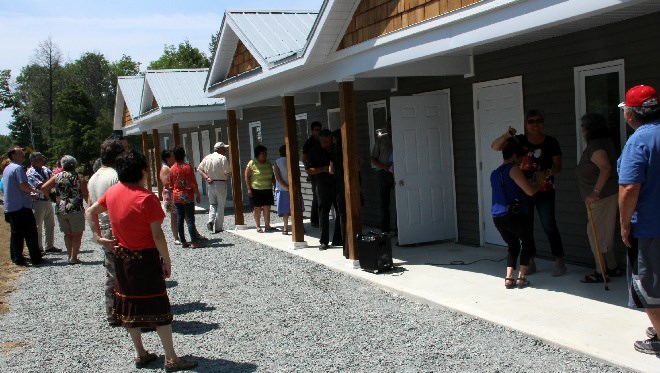Developed in partnership with several groups – including the Mike Holmes Foundation – the standard is more than just a building code, said Irving Leblanc, the associate director of housing, infrastructure and emergency issues with the Assembly of First Nations.
“It's not just about how you build a house, but it's how you build a community, how you plan a community and move it away from flood plains,” Leblanc said Friday at the ceremony unveiling the new units. “It's a great document that really looks at all aspects of community planning.”
The standard has been in the works since 2010, when Atikameksheng Anishnawbek was picked for the pilot project to work with the Holmes Group to build the units. It was developed over a three-year period, and includes such principles as assessing the best location for the homes, identify training needs for local residents, addressing financing issues, and identifying the most suitable building materials for the particular area.
Leblanc said too many First Nations were built on flood plains, causing a host of problems.
“A lot of the problems are due to mold, and that comes from water problems and poor building practices,” he said. “The goal is to build better, longer-lasting homes – healthy homes, green homes.”
Grand Council Chief Patrick Madahbee said the cycle of First Nations people living in substandard housing – only to be replaced by more substandard housing – must end. He's not aware of any First Nation in Canada that doesn't have a long waiting list of people waiting for homes.
“And what this does is get to the heart of (how) we can get these people good quality housing,” Madahbee said. “Atikameksheng Anishnawbek needs to be congratulated for this project, as well as all the partners involved.”
He likes the fact the standard also deals with financing issues problem unique to First Nations, because of land ownership rules. That draws out the process, meaning building often begins in the winter, driving up costs and making cutting corners much more of a problem. And First Nations are only eligible to receive around $35,000 for construction costs, Madahbee said, an amount that hasn't gone up even as costs increase.
“Every year, building costs and the cost of labour increase, but the funding has stayed the same for years,” he said. “In fact, particularly here in Ontario, capital funding has been almost non-existent … As we've seen in the past, when things aren't built to standard, the housing doesn't last long.
“So when First Nations get an opportunity to participate in a project like this, it's very beneficial to the community.”
Atikameksheng Anishnawbek Chief Steve Miller said while it wasn't always an easy process, he's proud of the commitment the partners showed in seeing it through to fruition.
“It was a long winter,” Miller said. “It was challenging, at times, but we did succeed ... It took dedication and perseverance to make this program a reality.
“My sincere thanks to each an every one of you.”
While Holmes couldn't attend Friday's ceremony, his daughter, Amanda, said dealing with housing problems on First Nations is something her father says must be a priority for everyone in Canada. And the best way to do that is empower First Nations with the knowledge and skills to determine their own way forward.
“My dad wanted me to tell you that this is a document developed by First Nations, for First Nations,” she said. “We were happy to help with the process, and to help First Nations for generations to come control their own destiny.
“The lessons learned and the challenges overcome in the last few years in Atikameksheng Anishnawbek can be shared with aboriginal peoples around the world.”
Holmes Homes director Seth Atkins said the initial perception was Mike Holmes was going to come here and show everybody how to build a house. But the goal was something entirely different: creating a blueprint that could be used in other communities.
“The results go far beyond building a four-plex for four people,” Atkins said.
Then he answered the question on many people's minds: will Holmes visit again to see the completed units?
“Mike wanted me to tell you he'll be coming out for a barbecue real soon.”
Other partners included Francis Lapointe of Lapointe Architects – who said his goal was to “put himself out of a job” by designing a model home that will last. And a new type of concrete was used – known Insulated Concrete Form – that is mold and fireproof.
Developed by Third Line Homes, the concrete also has built in sensors that send out data on the condition of the walls. The concrete also absorbs moisture when it's humid, and release it when it gets dry.
“These are homes that are healthy and sustainable,” said Jan Singbeil, of Third Line. “These homes will not burn down. These homes will not blow away.”
Join Sudbury.com+
- Messages
- Post a Listing
- Your Listings
- Your Profile
- Your Subscriptions
- Your Likes
- Your Business
- Support Local News
- Payment History
Sudbury.com+ members
Already a +member?
Not a +member?
Sign up for a Sudbury.com+ account for instant access to upcoming contests, local offers, auctions and so much more.
